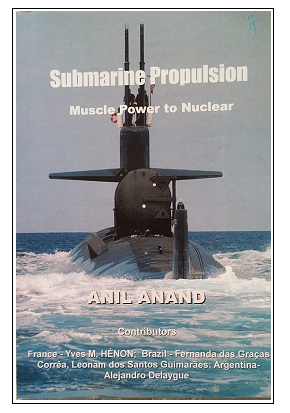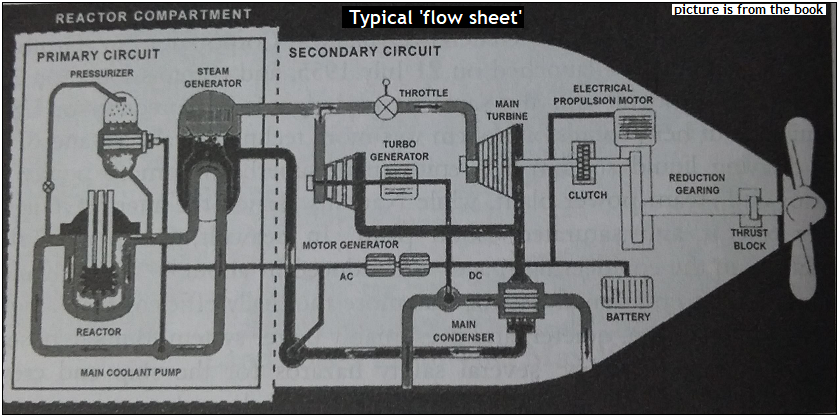In 2016, India became the first country outside the leading five, US, Russia, France, UK and China, to announce a nuclear-powered submarine, says S.Ananthanarayanan.

In a book that is just on the stands, Mr A K Anand, erstwhile Director, Reactor Projects Group of India’s Department of Atomic Energy, describes the story of how this achievement became possible.
And along the way, he relates much history, and politics, of the growth of submarines, worldwide, since Jules Verne’s imagination of the submersible Nautilus in the novel, ‘Twenty thousand leagues under the sea’.

The submersible, in naval warfare, had the obvious advantage of being invisible. It was hence the dream of naval forces to be able to sneak, undetected, up to enemy ships and destroy them by attack at their most vulnerable, in the hull. The difficulty, of course, was the technology and the propulsion, under water, without access to air that people and machines breathe.
The best answer was to drive the craft with electricity and batteries. As batteries had limited capacity and needed to be charged, the craft had to carry a diesel generator. And the craft had to come up to the surface for the diesel engine to run. Another way was to use a snorkel, like a diver uses, to take in air for the engine while the submarine stayed submerged. This had physical problems, of course, apart from water splashing into the snorkel pipe. And any method involved some exposure and detection, which would be followed by attack with depth charges
An improvement was the Air Independent Propulsion (AIP) technology, first developed by the German, Hellmuth Walter, using hydrogen peroxide as the fuel that did not need air to burn. When H2O2 burns, it produces superheated steam, which can drive a turbine, and it gives off oxygen, which is useful for the crew. The method, however, had the danger of explosion, A K Anand explains in the book. Other technologies were the Diesel or other engines with oxygen sources, like liquid oxygen, fuel cells or high capacity batteries. All of these, however, generally fell short of requirements and could not mature.
It was with the development of nuclear power that a picture of vast, pollution-free, and air independent, electricity for cities and industry and to power sea-going vessels came into view. In the case of submarines, there was the possibility of staying submerged for months on end and being able to use power freely, to attain high speeds.
In the book, Submarine Propulsions – Muscle Power to Nuclear’ (publisher: Frontier India Technology), Mr Anand describes the build-up, starting from sixteenth century manual contraptions, to the design of nuclear power for submarines. While the initial efforts in the US, after discovery of nuclear fission in 1939, were diverted to the production of the bomb during the war, the effort was resumed in the 1950s, in the US and in the then USSR. Over the decades since then, only 5 countries have developed functioning nuclear powered submarines, and in 2016, India became the sixth.
The technology bristles with challenges. Unlike a land-based nuclear power plant, where there is ample space, the nuclear installation within a submarine needs to be compact and yet able to use enough nuclear fuel to sustain a nuclear chain reaction. And then, with the crew in close proximity, the nuclear plant has to be shielded to protect the crew from radiation.
The principle of the nuclear reactor is that when the nucleus of U235, a form of the uranium atom, is struck by a stray neutron, splits into two more efficient parts and the packing energy that is saved is given off as heat. The break-up also creates a pair of neutrons, which can then set off other fission reactions, leading to a chain. Humungous heat is generated, to be drawn off by a coolant, and the process can be controlled by placing barriers between segments of uranium fuel. The heat drawn off by the coolant is used to generate steam, which drives a turbine, to generate electricity. The electricity then drives the propellers and the pumps that power the submarine.

While design to contain these systems within the confines of the submarine is challenging, the nuclear reactor itself needs features that are not found in regular reactors. The submarine reactor also does not have the facility of using natural uranium as fuel. Natural uranium has only a small percentage of U235, the kind that participates in nuclear fission. All the land based nuclear plants in India, except at Tarapur and Kudankulam, use natural uranium. This is not suitable for the submarine reactor, which needs enriched uranium, where the U235 has been concentrated. While India imports partly enriched fuel for reactors which need it under special arrangements, India has developed her own facility for enrichment of uranium for the submarine application. “..any new fuel geometry needs a lot of development work, so was it for PRP/Arihant,” says Mr Anand in a communication.
A conventional submarine would have only the battery and motor and a diesel generator. The nuclear sub need the electric motor, a steam driven generator and then the nuclear reactor with its controls and circulation system. A conventional nuclear plant is spread over an acre of land but there is probably no place that is more cramped than inside a submarine
These technical constraints, along with the need for safety and to contain radiation, make the design and construction of a nuclear power-pack for the submarine a task that calls for sophisticated capability. The know-how, naturally, is not available off the shelf and needs to be developed by each country on its own. India launched an audacious nuclear energy programme right after independence. While India now has a robust nuclear industry, with a large number of indigenous reactors in action, the development of the nuclear submarine signifies very high technological attainment. Mr Anand also describes the international resistance to share information and materials with India, especially as India has not signed the Nuclear Non-proliferation Treaty (on the grounds that it was discriminatory). And again, after the underground test that India carried out at Pokaran.
Mr Anand’s book is a study and a first-hand account of what it takes for a team of essentially first-generation scientists and engineers of the Department of Atomic Energy, working with engineers of the Indian Navy, to discover and master a technology held close by countries that were more advanced by orders of magnitude. Mr Anand reveals the working of the assorted talent that the department possesses in different areas of technology, the systems, the method of assurance of safety and quality, and the synergy that developed with naval engineers, that enabled the mastery, in a few short years after they had the political go-ahead, of the complexities of a new technology in an unfamiliar setting.
On the one hand, the book describes the growth of the idea of the submarine itself and then of nuclear power. And then the development of underwater nuclear propulsion, essentially a military application, and hence not for sharing. And then it brings out the different challenges, of the fuel, the design of systems, transfer of energy, the container, that the team faced and then the vision and confidence of the political leadership that allowed the team to give of its best.
The book is a personal story, at once history of the conquest of the underwater medium and a tribute to the organisation and the role of many individuals, dedicated, inspired and human.
------------------------------------------------------------------------------------------ Do respond to : response@simplescience.in